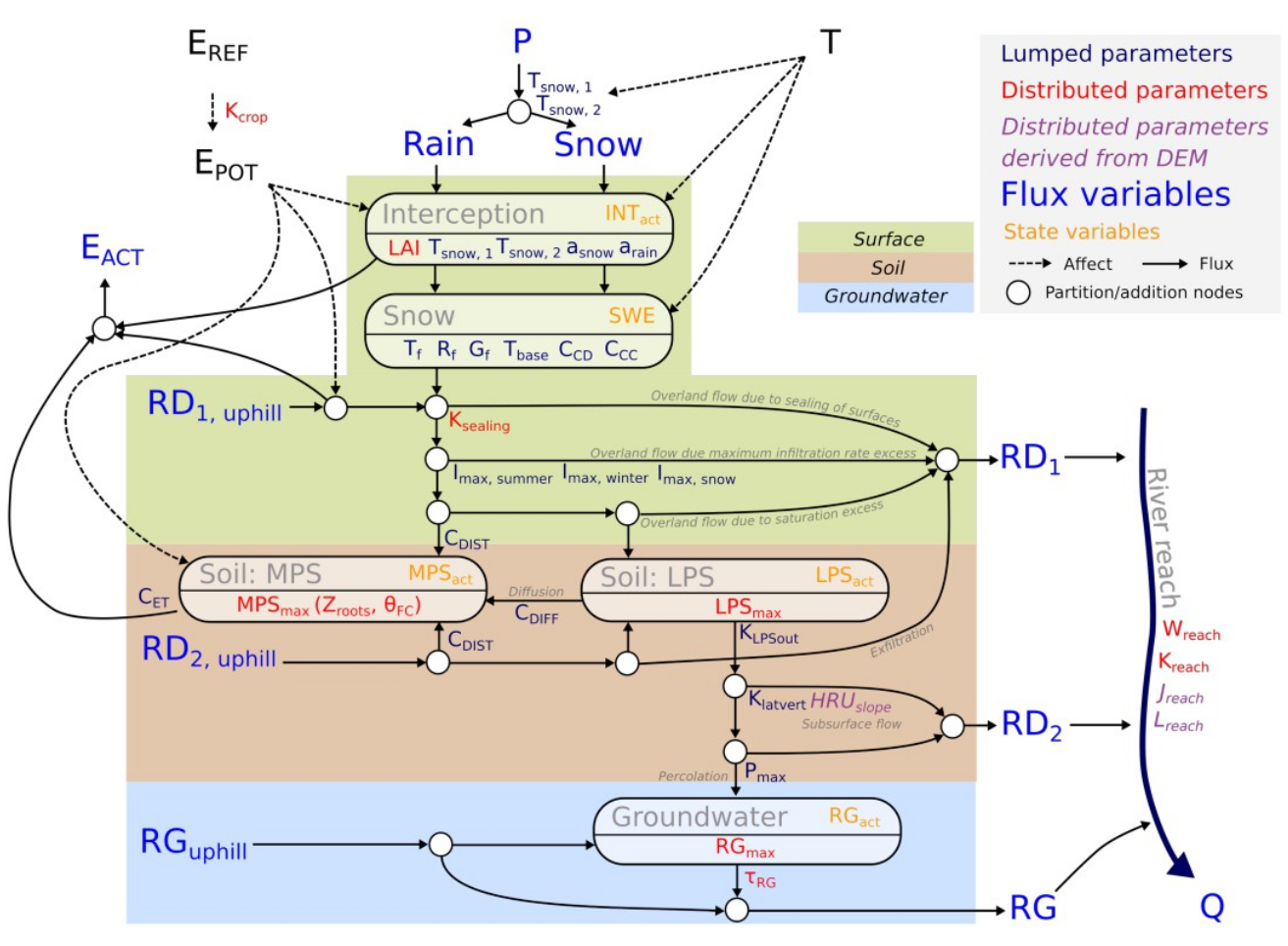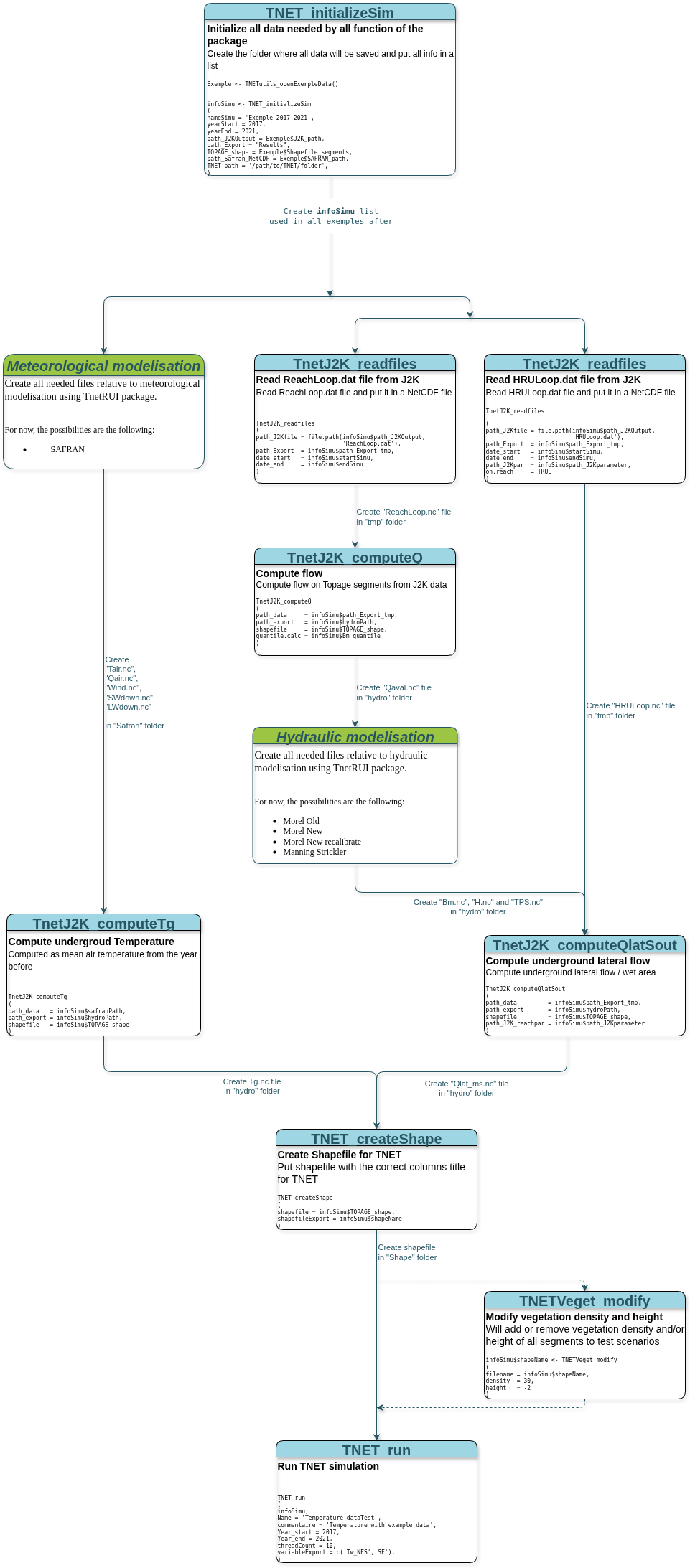Principe de J2000
The J2000 hydrological model was developed at Friedrich Schiller University in Jena (Germany) to address the challenges of the Water Framework Directive (Krause et al., 2006), and has been co-developed at INRAE Riverly since 2011. J2000 is a fully distributed model based on an irregular grid divided into hydrological response units (HRUs) (Flügel, 1995) (Kumar et al., 2013), obtained by cross-referencing layers of geographic information describing the relief (DTM), geology, pedology, and land use . The various hydrological processes are simulated in individual modules that are interconnected with each other. J2000 represents the main hydrological processes in a simplified manner, while maintaining a link with the physics of the phenomena, according to a “process-oriented” approach that retains the following processes:
- the division of precipitation between rain and snow
- the interception of precipitation by vegetation
- evapotranspiration
- snowmelt and snow accumulation processes
- soil infiltration
- surface runoff
- groundwater recharge and routing in the hydrographic network

Descriptive diagram of hydrological processes represented in J2000
The climate variables used as inputs for the model are temperature T, precipitation, and reference evapotranspiration. Since SAFRAN data is provided on an 8x8 km² grid, which is much larger than the average size of HRUs, only data from the nearest SAFRAN cell was taken into account.
Running T-NET with J2000 data
Data requirement in the shapefile
Some columns are needed in the hydrographic network shapefile in
order to use correctly the TnetRUI package. A shapefile columns can be
check using the TNETutils_checkShapefile() function. For
J2000 hydrological modelisation, all needed columns are detailed in the
following table:
| Column name | Explanation | Fonction |
|---|---|---|
| gid_new | ID of the segment | |
| ID_ND_INI | ID of the initial node | |
| ID_ND_FIN | ID of the final node | |
| RG_PCT_VEG | Percentage of the left bank of the segment covered by vegetation (0 - 100) | |
| RD_PCT_VEG | Percentage of the right bank of the segment covered by vegetation (0 - 100) | |
| RG_H_MOY | Mean height of the vegetation on the left bank (m) | |
| RD_H_MOY | Mean height of the vegetation on the right bank (m) | |
| Xcentr | X coordinates of the segment (WGS84) | TNETshape_computePosition |
| Ycentr | Y coordinates of the segment (WGS84) | TNETshape_computePosition |
| phi_deg | Orientation of the segment (angle with the north in degres) | TNETshape_computePosition |
| Longueur_m | Length of the segments (in km) | st_length |
| ID_M_1 | ID of the n°1 SAFRAN mesh crossed by the segment | TNETshape_getSafran |
| ID_M_2 | ID of the n°2 SAFRAN mesh crossed by the segment | TNETshape_getSafran |
| ID_M_3 | ID of the n°3 SAFRAN mesh crossed by the segment | TNETshape_getSafran |
| ID_M_4 | ID of the n°4 SAFRAN mesh crossed by the segment | TNETshape_getSafran |
| ID_M_5 | ID of the n°5 SAFRAN mesh crossed by the segment | TNETshape_getSafran |
| ID_M_6 | ID of the n°6 SAFRAN mesh crossed by the segment | TNETshape_getSafran |
| ID_M_7 | ID of the n°7 SAFRAN mesh crossed by the segment | TNETshape_getSafran |
| ID_M_8 | ID of the n°8 SAFRAN mesh crossed by the segment | TNETshape_getSafran |
| Rap_M_1 | Aspect ratio of the segment in the n°1 SAFRAN mesh | TNETshape_getSafran |
| Rap_M_2 | Aspect ratio of the segment in the n°2 SAFRAN mesh | TNETshape_getSafran |
| Rap_M_3 | Aspect ratio of the segment in the n°3 SAFRAN mesh | TNETshape_getSafran |
| Rap_M_4 | Aspect ratio of the segment in the n°4 SAFRAN mesh | TNETshape_getSafran |
| Rap_M_5 | Aspect ratio of the segment in the n°5 SAFRAN mesh | TNETshape_getSafran |
| Rap_M_6 | Aspect ratio of the segment in the n°6 SAFRAN mesh | TNETshape_getSafran |
| Rap_M_7 | Aspect ratio of the segment in the n°7 SAFRAN mesh | TNETshape_getSafran |
| Rap_M_8 | Aspect ratio of the segment in the n°8 SAFRAN mesh | TNETshape_getSafran |
| J2000 | J2000 reach linked to the segment | |
| P_J2000 | Is the segment the most downstream segment of the J2000 linked reach ? (1 if yes - 0 if not) | |
| RppAr_v | Ratio of the total drain area use to dispatch discharge data from J2000 reach | TNETshape_computeCoefQcalc |
| RppA_BV | Ratio of the sub-watershed drain area use to dispatch lateral discharge data from J2000 reach | TNETshape_computeCoefQcalc |
Functions arrangement
All function relative to J2000 hydrological function are regrouped in the TnetJ2K group. The functions are the following:
TnetJ2K_readfiles()will read output file from J2000 computation. It has to be used two times: one to read the ReachLoop.dat file (to extract discharge data) and another one to read HRUloop.dat file (to extract underground flow data).TnetJ2K_computeQ()will dispatch discharge and underground data from J2000 river network to Topage river network using specific discharge hypothesis.TnetJ2K_computeQlatSout()will compute undergroud lateral discharge on every Topage river segment using J2000 underground flow and river depth and width.TnetJ2K_computeTg()will compute underground water temperature usin the moving average of air temperature on 365 days.

A diagram showing how to run a T-NET computation with J2000 hydrological modelisation
Data format
TnetRUI functions using J2000 modelisation will need the following files created by J2000:
An exemple of each file are distributed with TnetRUI package in order run the Ardière exemple can be found in the DataTnetRUI repository and are detailed in the following sections.
All data will be downloaded when using
TNETutils_openExempleData() for the first time.
ReachLoop.dat file
The ReachLoop.dat file contain all the modelisation data
on each J2000 reach.
For TnetRUI, the needed parameter is Runoff that contain
the discharde data of all reach. This file can easely be read by
TNET_readJ2K() in order to be put in a NetCDF file.
Here a part of the ReachLoop.dat file shared in the DataTnetRUI
repository:
#> @context
#> jams.components.core.SpatialContext ReachLoop 7
#> @ancestors
#> jams.components.core.TemporalContext TimeLoop 1673
#> @filters
#> @attributes
#> ID Runoff inRG1 outRG1
#> @types
#> JAMSLong JAMSDouble JAMSDouble JAMSDouble
#> @data
#> TimeLoop 2017-01-01 00:00
#> @start
#> 23400 3003937.368852 0.000000 2711460.730610
#> 23600 2212143.834318 0.000000 1983943.980064
#> 23200 6068979.622878 0.000000 5318955.416990
#> 23800 1129869.329902 0.000000 931463.727352
#> 23000 7752881.392078 0.000000 6626987.555175
#> 24000 3446009.844058 0.000000 2702001.425618
#> 22800 14581802.569821 0.000000 11809501.061738
#> @end
#> TimeLoop 2017-01-02 00:00
#> @start
#> 23400 2958862.099614 0.000000 2702130.408796
#> 23600 2185745.260217 0.000000 1974226.089462
#> 23200 5967217.492028 0.000000 5309667.140031
#> 23800 1106553.787048 0.000000 922588.402148
#> 23000 7609000.752317 0.000000 6612787.221729
#> 24000 3367977.562572 0.000000 2696880.171869
#> 22800 14259914.190175 0.000000 11837642.572676
#> @end
#> TimeLoop 2017-01-03 00:00
#> @start
#> ...
#> @end
#> TimeLoop 2021-07-31 00:00
#> @start
#> 23400 1155602.073093 0.000000 1025231.775009
#> 23600 857173.447102 0.000000 855773.739958
#> 23200 2253475.611039 0.000000 1943714.773857
#> 23800 161374.326843 0.000000 158310.835242
#> 23000 2538240.951849 0.000000 2146527.479091
#> 24000 986053.656758 0.000000 830658.402173
#> 22800 6322102.798173 0.000000 5006434.922922
#> @endreach.par file
The reach.par file contain the different parameter of
each reachs used by J2000.
For TnetRUI, it is used to create the topology of the J2000
hydrological network (with the to-reach column) in order to
add all underground lateral discharge.
Here is the reach.par file shared in the DataTnetRUI
repository:
#> # reach.par created at Tue 21 May 2024 09:10:15 r.reach.par called by HRU-delin
#> ID to-reach length slope sinuosity rough width TA
#> 0 0 0 0 1 0 0 0
#> 999999 999999 99999 90999999 9999 9999 9999 9999
#> n/a n/a m % n/a n/a m n/a
#> 22800 22400 3750 1.28 1.0 15 7.46300347115294 1
#> 23000 22800 824 2.3058 1.1 15 5.52089991769009 1
#> 23200 23000 2071 1.8349 1.12 15 4.88029255743067 1
#> 23400 23200 3777 3.9979 1.28 15 3.43751025216991 1
#> 23600 23200 1263 5.8591 1.14 15 2.87766303715962 1
#> 23800 23000 1035 4.2512 1.22 15 2.14837018065897 1
#> 24000 22800 3744 4.2201 1.12 15 3.78998031743936 1HRULoop.dat file
The HRULoop.dat file contain all the modelisation data
on each J2000 HRU. It’s on the same format as the ReachLoop.dat file.
For TnetRUI, the needed parameter is RG1OUT that contain
the underground lateral discharge data of all HRUs. The data on the HRU
are put on the J2000 reachs using the hru.par file.
This file can easily be read by TNET_readJ2K() in order to
be put in a NetCDF file.
Here a part of the HRULoop.dat file shared in the DataTnetRUI
repository:
#> @context
#> jams.components.core.SpatialContext HRULoop 8
#> @ancestors
#> jams.components.core.TemporalContext TimeLoop 1673
#> @filters
#> @attributes
#> ID RD1OUT RD2OUT RG1OUT
#> @types
#> JAMSLong JAMSDouble JAMSDouble JAMSDouble
#> @data
#> TimeLoop 2017-01-01 00:00
#> @start
#> 6499 0.000000 221559.382175 2735507.370070
#> 6481 0.000000 216063.227531 1986288.454040
#> 6497 0.000000 129619.707132 660978.075657
#> 6526 0.000000 188598.011283 932668.143001
#> 6549 0.000000 130005.553740 393240.252756
#> 6595 0.000000 270340.909474 986967.339838
#> 6558 0.000000 350905.343766 1756918.877863
#> 6556 0.000000 469412.149252 2669493.970525
#> @end
#> TimeLoop 2017-01-02 00:00
#> @start
#> 6499 0.000000 212987.032814 2713057.171269
#> 6481 0.000000 205690.277614 1974222.851729
#> 6497 0.000000 124375.244366 654419.817864
#> 6526 0.000000 178912.592079 922201.898474
#> 6549 0.000000 124154.159177 389590.737600
#> 6595 0.000000 256457.597458 975891.758887
#> 6558 0.000000 333450.998453 1747772.026645
#> 6556 0.000000 444256.532810 2662293.478898
#> @end
#> TimeLoop 2017-01-03 00:00
#> @start
#> ...
#> @end
#> TimeLoop 2021-07-31 00:00
#> @start
#> 6499 0.000000 0.000000 1092710.599520
#> 6481 0.000000 0.000000 852011.687296
#> 6497 0.000000 0.000000 153443.282084
#> 6526 0.000000 0.000000 158949.747810
#> 6549 0.000000 0.000000 83958.900591
#> 6595 0.000000 0.000000 168203.675595
#> 6558 0.000000 0.000000 739944.975943
#> 6556 0.000000 0.000000 2409965.337740
#> @endhru.par file
The hru.par file contain the different parameter of each
HRU used by J2000.
For TnetRUI, it is used to know the HRU having an output discharge in
a reach (with the to-reach column) in order to add
underground lateral discharge from the HRUs to the reaches.
Here is the reach.par file shared in the DataTnetRUI
repository:
#> # hru.par created Tue 21 May 2024 09:10:22 by HRU-DELIN_BATCH
#> ID area elevation slope aspect x y watershed subbasin hgeoID landuseID soilID to_poly to_reach irrigated irrig_type irrig_source_reach irrig_source_hru
#> 0 0 0 0 0 0 0 0 0 0 0 0 0 0 0 0 0 0
#> 999999 9999999 10000 90 360 9999999 9999999 999999 999999 9999 9999 9999 999999 999999 999999 999999 999999 999999
#> n/a m2 m deg deg m m n/a n/a n/a n/a n/a n/a n/a n/a n/a n/a n/a
#> 6481 3615000 574 12.642 272 816725 6568050 1009 23600 6 4 4 0.0 23600.0 0 0 0 0
#> 6497 4553125 474 11.043 9 821200 6567125 1009 23200 6 4 4 0.0 23200.0 0 0 0 0
#> 6499 7128125 603 10.655 91 814525 6567525 1009 23400 6 4 4 0.0 23400.0 0 0 0 0
#> 6526 4443750 591 12.125 76 820275 6564375 1009 23800 6 2 4 0.0 23800.0 0 0 0 0
#> 6549 2750000 570 15.132 184 821600 6566075 1009 23000 6 3 4 0.0 23000.0 0 0 0 0
#> 6556 5576875 465 16.206 265 822212.5 6563100 1009 22800 6 3 4 0.0 22800.0 0 0 0 0
#> 6558 5437500 546 15.292 281 818950 6563175 1009 24000 6 4 4 0.0 24000.0 0 0 0 0
#> 6595 5168125 678 14.831 89 817950 6560700 1009 24000 6 2 4 0.0 24000.0 0 0 0 0